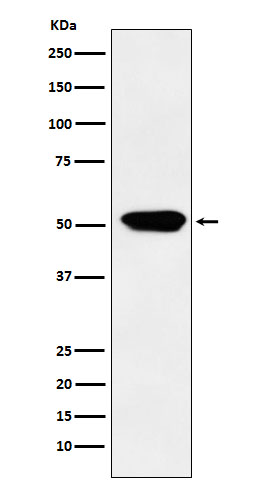Cytochrome P450 4A Antibody
Rabbit mAb
- SPECIFICATION
- CITATIONS
- PROTOCOLS
- BACKGROUND

Application
| WB, IHC, IP |
|---|---|
| Primary Accession | Q02928 |
| Reactivity | Rat |
| Clonality | Monoclonal |
| Other Names | CYP4A; Cyp4a1; Cyp4a10; CYP4A11; Cyp4a14; Cyp4a3; CYP4A7; CYP4AII; CYPIVA11; |
| Isotype | Rabbit IgG |
| Host | Rabbit |
| Calculated MW | 59348 Da |
| Dilution | WB 1:500~1:2000 IHC 1:50~1:200 IP 1:50 |
|---|---|
| Purification | Affinity-chromatography |
| Immunogen | A synthesized peptide derived from human Cytochrome P450 4A |
| Description | Catalyzes the omega- and (omega-1)-hydroxylation of various fatty acids such as laurate, myristate and palmitate. Has little activity toward prostaglandins A1 and E1. Oxidizes arachidonic acid to 20-hydroxyeicosatetraenoic acid (20-HETE). |
| Storage Condition and Buffer | Rabbit IgG in phosphate buffered saline , pH 7.4, 150mM NaCl, 0.02% sodium azide and 50% glycerol. Store at +4°C short term. Store at -20°C long term. Avoid freeze / thaw cycle. |
| Name | CYP4A11 {ECO:0000303|PubMed:8274222, ECO:0000312|HGNC:HGNC:2642} |
|---|---|
| Function | A cytochrome P450 monooxygenase involved in the metabolism of fatty acids and their oxygenated derivatives (oxylipins) (PubMed:10553002, PubMed:10660572, PubMed:15611369, PubMed:1739747, PubMed:7679927, PubMed:8914854). Mechanistically, uses molecular oxygen inserting one oxygen atom into a substrate, and reducing the second into a water molecule, with two electrons provided by NADPH via cytochrome P450 reductase (CPR; NADPH-ferrihemoprotein reductase) (PubMed:10553002, PubMed:10660572, PubMed:15611369, PubMed:1739747, PubMed:7679927, PubMed:8914854). Catalyzes predominantly the oxidation of the terminal carbon (omega-oxidation) of saturated and unsaturated fatty acids, the catalytic efficiency decreasing in the following order: dodecanoic > tetradecanoic > (9Z)-octadecenoic > (9Z,12Z)- octadecadienoic > hexadecanoic acid (PubMed:10553002, PubMed:10660572). Acts as a major omega-hydroxylase for dodecanoic (lauric) acid in liver (PubMed:15611369, PubMed:1739747, PubMed:7679927, PubMed:8914854). Participates in omega-hydroxylation of (5Z,8Z,11Z,14Z)-eicosatetraenoic acid (arachidonate) to 20-hydroxyeicosatetraenoic acid (20-HETE), a signaling molecule acting both as vasoconstrictive and natriuretic with overall effect on arterial blood pressure (PubMed:10620324, PubMed:10660572, PubMed:15611369). Can also catalyze the oxidation of the penultimate carbon (omega-1 oxidation) of fatty acids with lower efficiency (PubMed:7679927). May contribute to the degradation of saturated very long-chain fatty acids (VLCFAs) such as docosanoic acid, by catalyzing successive omega-oxidations to the corresponding dicarboxylic acid, thereby initiating chain shortening (PubMed:18182499). Omega-hydroxylates (9R,10S)-epoxy-octadecanoate stereoisomer (PubMed:15145985). Plays a minor role in omega-oxidation of long-chain 3-hydroxy fatty acids (PubMed:18065749). Has little activity toward prostaglandins A1 and E1 (PubMed:7679927). |
| Cellular Location | Endoplasmic reticulum membrane; Peripheral membrane protein. Microsome membrane; Peripheral membrane protein |
| Tissue Location | Expressed in liver (PubMed:7679927). Expressed in S2 and S3 segments of proximal tubules in cortex and outer medulla of kidney (PubMed:10660572, PubMed:7679927). |

Thousands of laboratories across the world have published research that depended on the performance of antibodies from Abcepta to advance their research. Check out links to articles that cite our products in major peer-reviewed journals, organized by research category.
info@abcepta.com, and receive a free "I Love Antibodies" mug.
Provided below are standard protocols that you may find useful for product applications.
If you have used an Abcepta product and would like to share how it has performed, please click on the "Submit Review" button and provide the requested information. Our staff will examine and post your review and contact you if needed.
If you have any additional inquiries please email technical services at tech@abcepta.com.













 Foundational characteristics of cancer include proliferation, angiogenesis, migration, evasion of apoptosis, and cellular immortality. Find key markers for these cellular processes and antibodies to detect them.
Foundational characteristics of cancer include proliferation, angiogenesis, migration, evasion of apoptosis, and cellular immortality. Find key markers for these cellular processes and antibodies to detect them. The SUMOplot™ Analysis Program predicts and scores sumoylation sites in your protein. SUMOylation is a post-translational modification involved in various cellular processes, such as nuclear-cytosolic transport, transcriptional regulation, apoptosis, protein stability, response to stress, and progression through the cell cycle.
The SUMOplot™ Analysis Program predicts and scores sumoylation sites in your protein. SUMOylation is a post-translational modification involved in various cellular processes, such as nuclear-cytosolic transport, transcriptional regulation, apoptosis, protein stability, response to stress, and progression through the cell cycle. The Autophagy Receptor Motif Plotter predicts and scores autophagy receptor binding sites in your protein. Identifying proteins connected to this pathway is critical to understanding the role of autophagy in physiological as well as pathological processes such as development, differentiation, neurodegenerative diseases, stress, infection, and cancer.
The Autophagy Receptor Motif Plotter predicts and scores autophagy receptor binding sites in your protein. Identifying proteins connected to this pathway is critical to understanding the role of autophagy in physiological as well as pathological processes such as development, differentiation, neurodegenerative diseases, stress, infection, and cancer.


